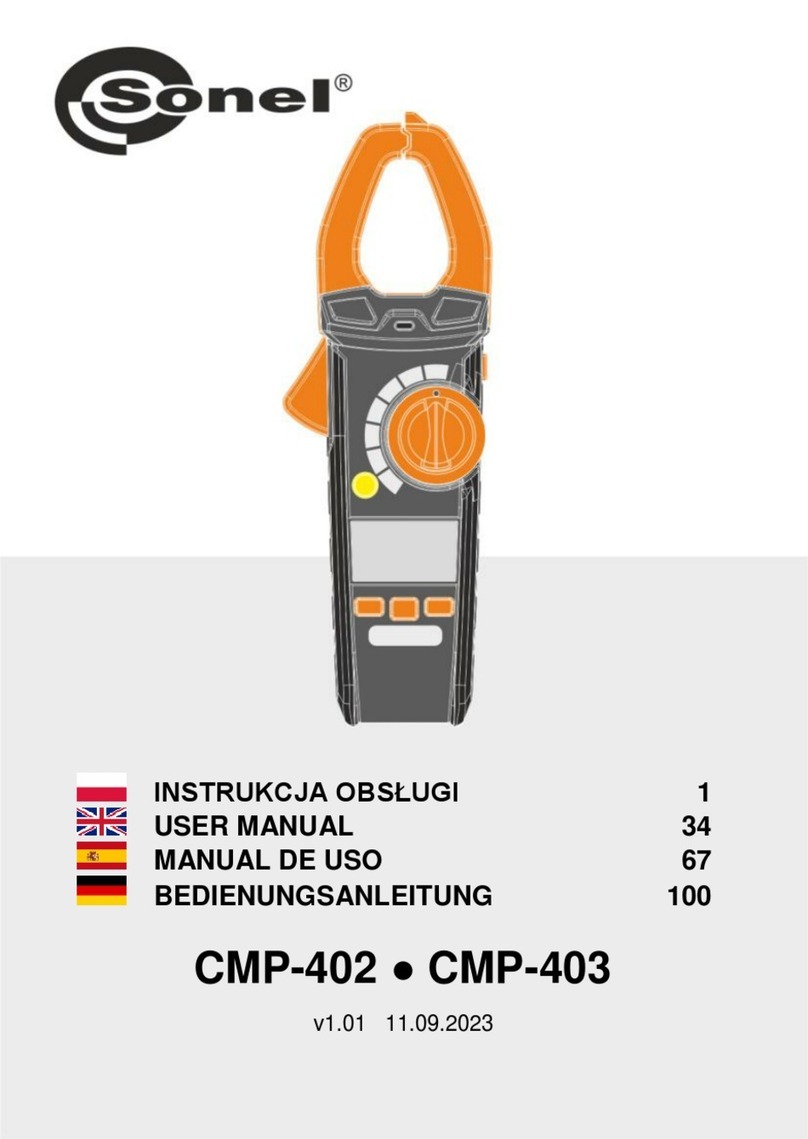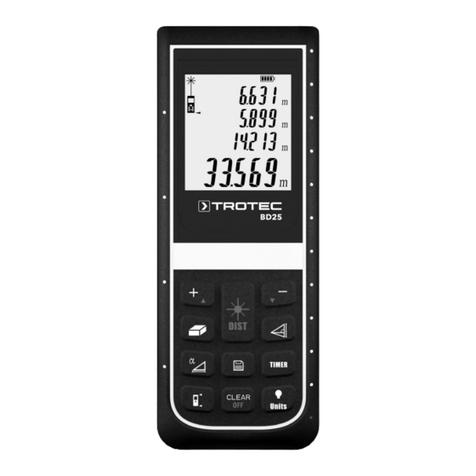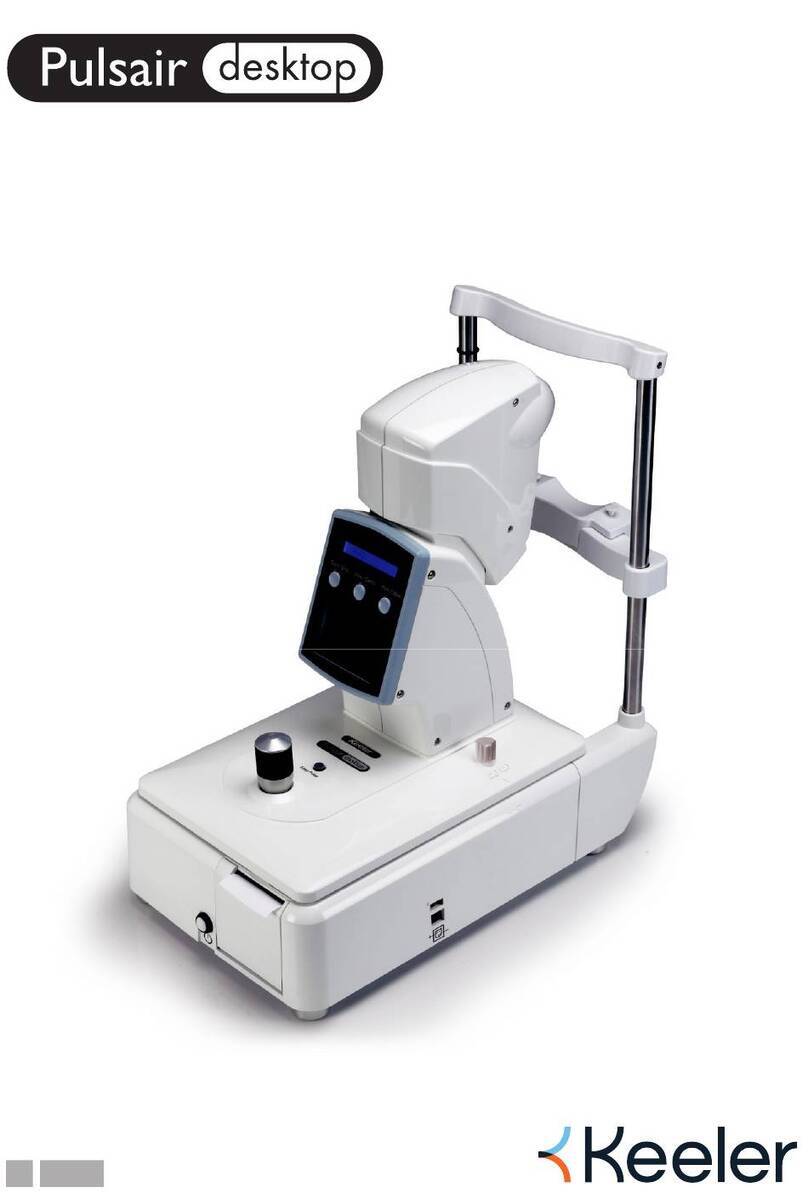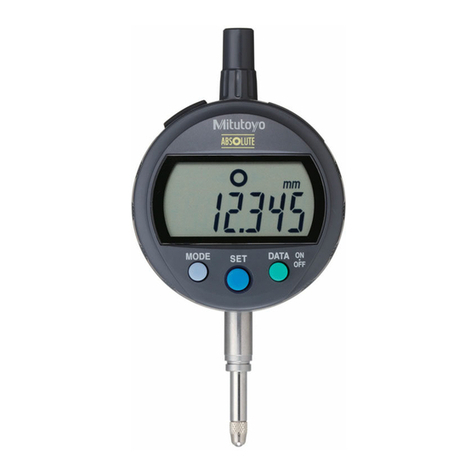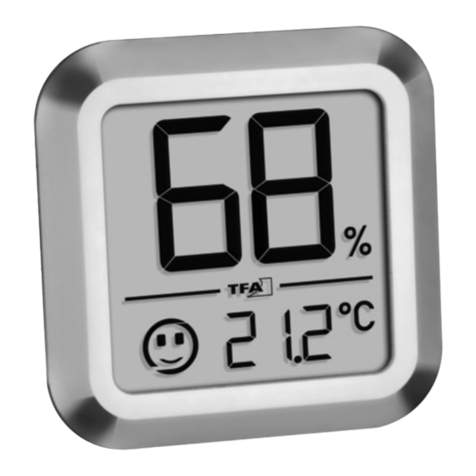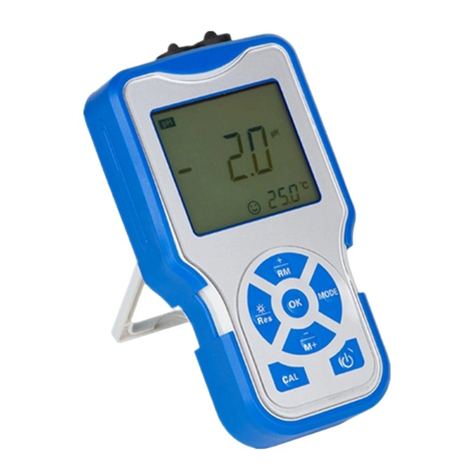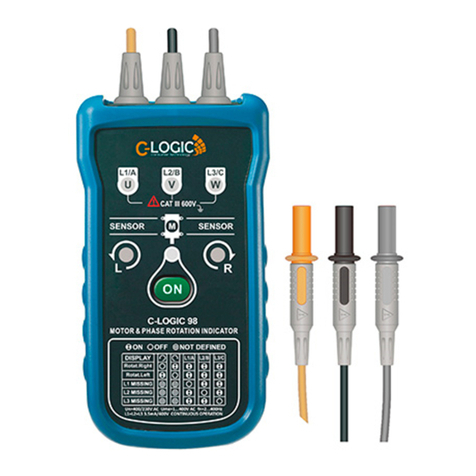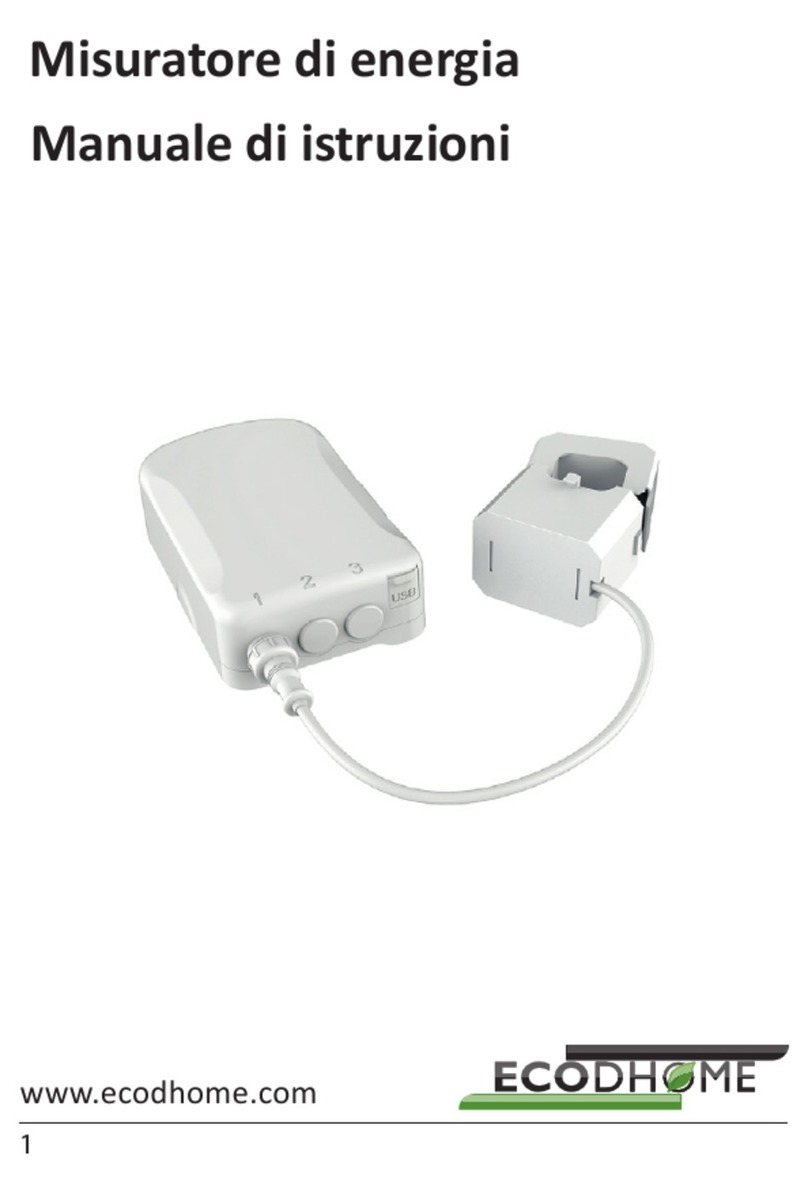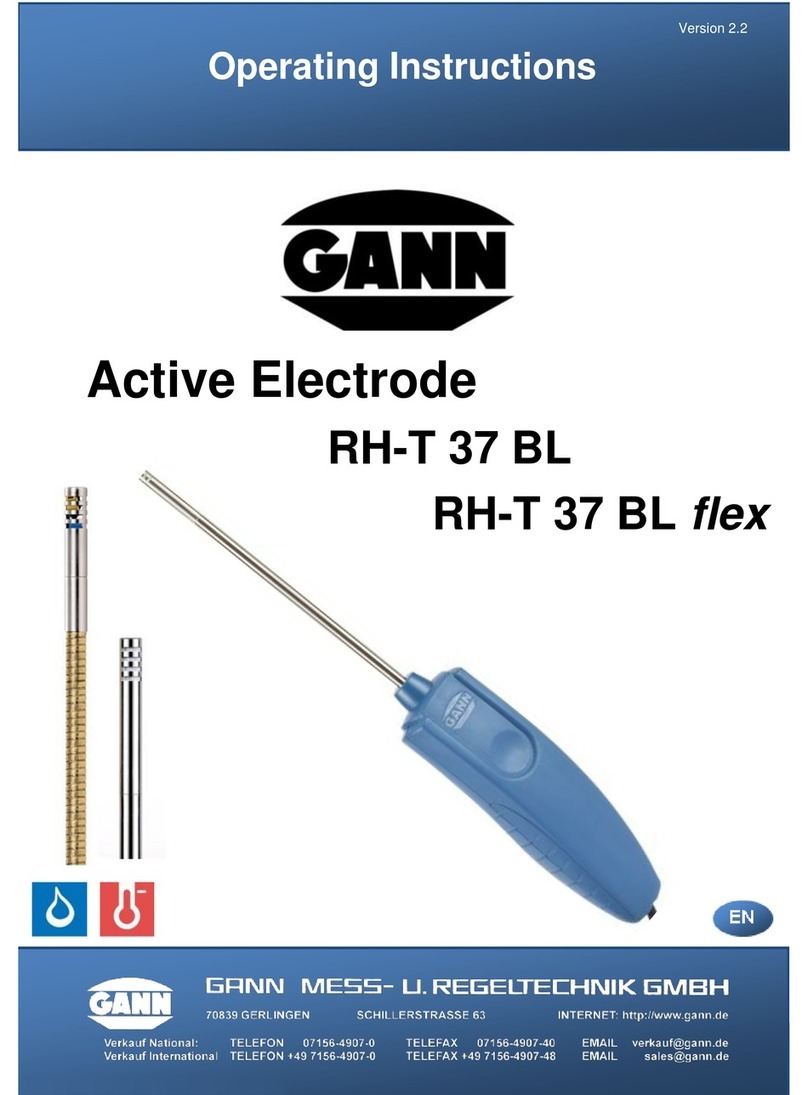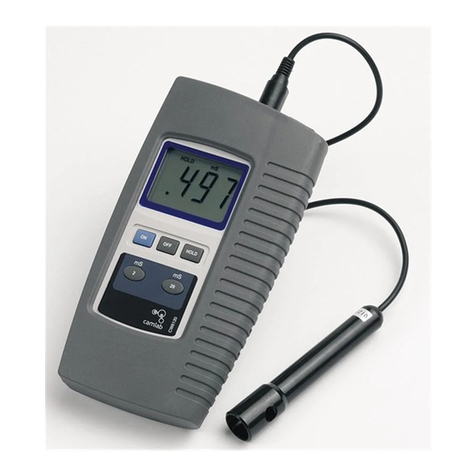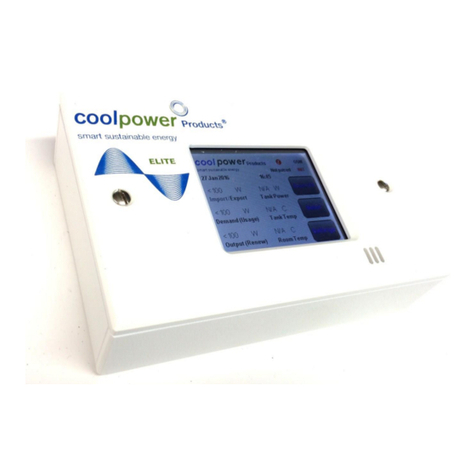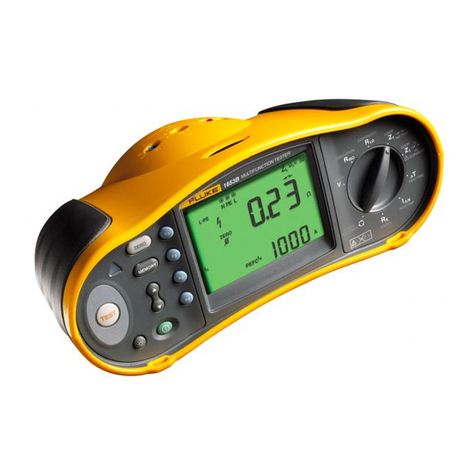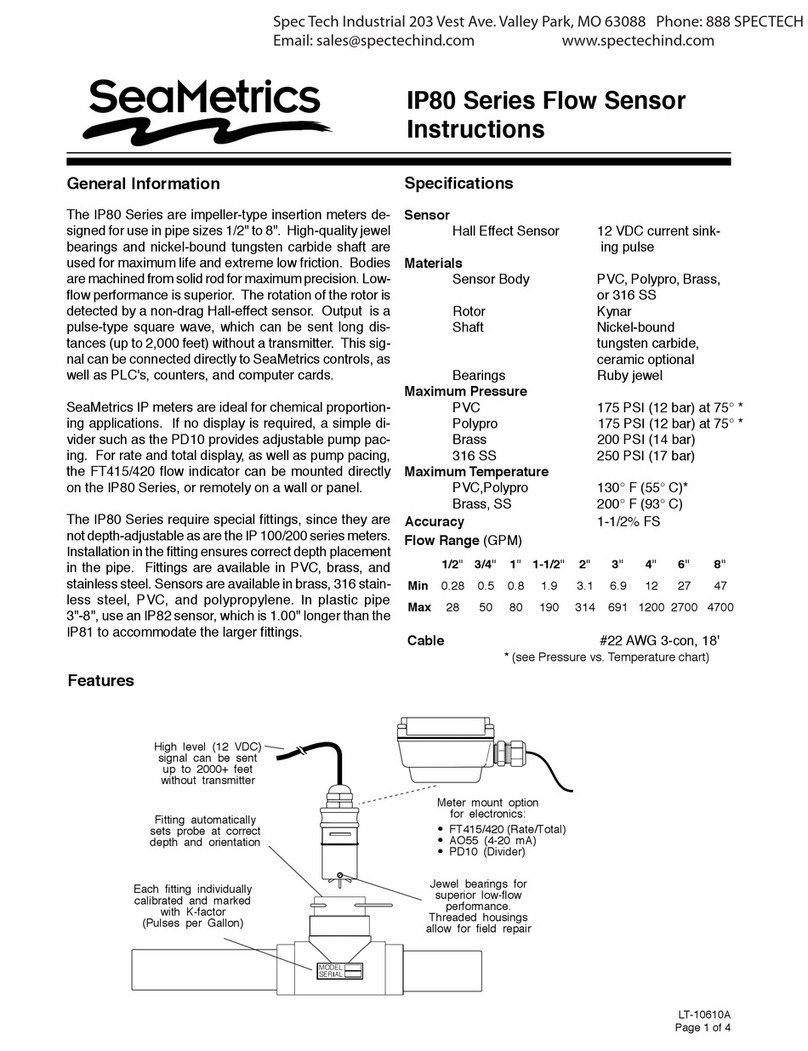Sonel MIC-10 User manual



OPERATING MANUAL
INSULATION RESISTANCE METER
MIC-10
SONEL SA
ul. Wokulskiego 11
58-100 Świdnica, Poland
Version 1.02 09/12/2012

OPERATING MANUAL MIC-10 version 1.02
2
MIC-10 meter is a modern, easy and safe measuring device. Please acquaint yourself with the
present manual in order to avoid measuring errors and prevent possible problems related to operation
of the meter.

OPERATING MANUAL MIC-10 version 1.02
3
CONTENTS
1SAFETY ....................................................................................................................5
2METER CONFIGURATION..................................................................................6
3MEASUREMENTS..................................................................................................7
3.1 MEASUREMENT OF INSULATION RESISTANCE ...........................................................7
3.2 LOW-VOLTAGE MEASUREMENT OF RESISTANCE......................................................11
3.2.1 Measurement of resistance of protective conductors and equipotential
bonding with 200 mA current......................................................................11
3.2.2 Measurement of resistance ..........................................................................12
3.2.3 Compensation of test leads resistance .........................................................13
3.3 VOLTAGE MEASUREMENT .....................................................................................14
3.4 REMEMBERING THE LAST MEASUREMENT RESULT ..................................................15
4POWER SUPPLY OF THE METER ...................................................................16
4.1 MONITORING OF THE POWER SUPPLY VOLTAGE .....................................................16
4.2 REPLACING BATTERY/RECHARGEABLE BATTERIES ..................................................16
4.3 GENERAL PRINCIPLES REGARDING USING NIMH RECHARGEABLE BATTERIES..........17
5CLEANING AND MAINTENANCE ...................................................................18
6STORAGE ..............................................................................................................18
7DISMANTLING AND DISPOSAL ......................................................................18
8TECHNICAL SPECIFICATIONS .......................................................................19
8.1 BASIC DATA..........................................................................................................19
8.2 ADDITIONAL DATA................................................................................................21
8.2.1 Additional uncertainties according to IEC 61557-2 (RISO)..........................21
8.2.2 Additional uncertainties according to IEC 61557-4 (RCONT 200mA)...........21
9EQUIPMENT .........................................................................................................22
9.1 STANDARD EQUIPMENT ........................................................................................22
9.2 OPTIONAL ACCESSORIES.......................................................................................22
10 MANUFACTURER ...............................................................................................23

OPERATING MANUAL MIC-10 version 1.02
4

OPERATING MANUAL MIC-10 version 1.02
5
1 Safety
MIC-10 meter is designed for performing check tests of protection against electric shock in mains
systems. The meter is used for making measurements and providing results to determine safety of
electrical installations. Therefore, in order to provide conditions for correct operation and the
correctness of the obtained results, the following recommendations must be observed:
•Before you proceed to operate the meter, acquaint yourself thoroughly with the present manual
and observe the safety regulations and specifications determined by the producer.
•Any application that differs from those specified in the present manual may result in a damage to
the device and constitute a source of danger for the user.
•MIC-10 meters must be operated only by appropriately qualified personnel with relevant
certificates authorising the personnel to perform works on electric systems. Operating the meter by
unauthorised personnel may result in damage to the device and constitute a source of danger for
the user.
•During measurements of insulation resistance, dangerous voltage up to 1 kV occurs at the ends of
test leads of the meter.
•Before the measurement of insulation resistance you must be sure that tested object is
disconnected from the power supply
•During the measurement of insulation resistance do not disconnect test leads from the tested
object before the measurement is completed (see par. 3.1); otherwise the capacitance of the
object will not be discharged, creating the risk of electric shock,
•Operation of the meter realised by unauthorised personnel may result in damage to the device and
constitute a source of danger for the user.
•It is unacceptable to operate the following:
⇒A damaged meter which is completely or partially out of order,
⇒A meter with damaged test leads insulation,
⇒A meter stored for an excessive period of time in disadvantageous conditions (e.g. excessive
humidity). If the meter has been transferred from a cool to a warm environment with a high
level of relative humidity, do not start measurements until the meter is warmed up to the
ambient temperature (approximately 30 minutes).
•Displayed BATT symbol indicates insufficient voltage of power supply and the need to charge the
accumulator or replace batteries.
•Symbols ErrX, where Xis a number 1…9, indicate incorrect operation of the meter. If after
restarting the device this situation is repeated - it indicates that the meter is damaged.
•Before measurement, choose a correct measurement function and make sure that test leads are
connected to respective measuring terminals.
•Do not operate a meter with an open or incorrectly closed battery (accumulator) compartment or
power it from other sources than those specified in the present manual.
•Meter inputs are electronically protected against overloads (caused by e.g. connecting the meter
to a live circuit) up to 550V, for voltmeter up to 600V.
•Repairs may be carried out only by an authorised service point.
Note:
Due to continuous development of the meter’s software, the actual appearance of the display,
in case of some of the functions, may slightly differ from the display presented in this
operating manual.

OPERATING MANUAL MIC-10 version 1.02
6
2 Meter Configuration
Turn on the meter by pressing and
keeping SET/SEL button pressed.
Use and buttons to go to the next
parameter.
Use and buttons to change the parameter
value. The value or symbol to be changed is
flashing.
The symbol indicates an active parameter,
the - symbol indicates an inactive one.
Set the parameters according to the following algorithm:
Parameter
Auto-
OFF
Beep
signalling
pressed
push-button
Selection
of
power
supply
source
Symbol(s)
Press ENTER to validate the last change and go to
the measurement function,
or
Press ESC to go the measurement function
without validating the changes.

OPERATING MANUAL MIC-10 version 1.02
7
3 Measurements
3.1 Measurement of insulation resistance
WARNING:
Measured object must not be live.
Note:
During measurement, especially of high resistances, make sure that test leads
do not touch each other and the probe (crocodile clips), because such a contact
may cause the flow of surface currents resulting in additional error in
measurement results.
Set the rotary switch of function
selection at one of RISO positions,
selecting simultaneously
measuring voltage. The meter is
in the voltage measurement
mode.
Connect test leads according to the drawing.

OPERATING MANUAL MIC-10 version 1.02
8
The meter is ready
for measurement.
Press and hold START push-button.
The measurement is performed continuously
until you release the button or the pre-set time
is reached.
In order to maintain (lock) the measurement
order to maintain the measurement, press
ENTER while holding START - push-button
pressed - the following symbol will be
displayed . In order to interrupt the
measurement, press ESC or START.
View of the screen
during
measurement.
After measuring is
completed, read the
result.

OPERATING MANUAL MIC-10 version 1.02
9
Use and to see the capacitance of the tested
object.
In order to eliminate the influence of surface currents in the devices of up to 1kV, a three-lead
measurement is used. For example, to measure the inter-winding resistance of a small motor,
connect G socket of the meter with the motor housing:
Notes:
During measurements of insulation resistance, dangerous voltage up to 1 kV
occurs at the ends of test leads of MIC-10 meter.

OPERATING MANUAL MIC-10 version 1.02
10
It is forbidden to disconnect test leads before the measurement is completed.
Failure to obey the above instruction will lead to high voltage electric shock and
make it impossible to discharge the object tested.
- Symbol LIMIT I! indicates working with current limiting (e.g. when charging an object).
- If the work with limited current lasts for 20 seconds, the measurement is interrupted.
- Capacitance of the object is measured at the end of the measurement during the object discharge.
- After completion of measurement, the capacitance of the object tested is discharged by shorting test
terminals with the resistance of 100kΩ.
Additional information displayed by the meter
Test voltage is present on terminals of the meter.
You must consult the manual.
The meter is ready for measurement.
This inscription displayed after the measurement indicates
noise in the system during the measurement. The
measurement result may be affected by additional
uncertainty.
Activation of current limit. The symbol displayed is
accompanied by a continuous audio signal.
Leakage current too high (breakdown of insulation during
the measurement.)
Discharging of the object tested after the measurement.
two-tone acoustic
signal
The tested object is live. The measurement is blocked.
Discharged batteries (rechargeable batteries).

OPERATING MANUAL MIC-10 version 1.02
11
3.2 Low-voltage measurement of resistance
3.2.1 Measurement of resistance of protective conductors and equipotential
bonding with 200 mA current
NOTE
MIC-10 meter measures RCONT unidirectionally.
Set the rotary switch of function
selection at RCONT position.
The meter is ready for
measurement.
Connect the meter to the object tested.
The measurement starts automatically when the meter detects a
resistance within the measurement range.
The measurement may be also triggered manually by pressing
START
push-button.

OPERATING MANUAL MIC-10 version 1.02
12
Read the result.
Press START push-button in order to start a next
measurement without disconnecting test leads from
the object.
Additional information displayed by the meter
This inscription displayed after the measurement
indicates noise in the system during the measurement
The measurement result may be affected by additional
uncertainty.
two-tone acoustic
signal
The tested object is live. The measurement is blocked.
Resistance compensation completed for test leads
The compensation resistance is taken into
consideration when displaying result.
3.2.2 Measurement of resistance
Set the rotary switch of function
selection at RXposition.
The meter is ready for
measurement.

OPERATING MANUAL MIC-10 version 1.02
13
Connect the meter to the object tested. The measurement is
continuous.
Read out the result.
Note:
- For R <30Ω there is a continuous beep.
3.2.3 Compensation of test leads resistance
In order to eliminate the impact of the resistance of test leads on measurement result (RCONT and
RX), the compensation (auto-zeroing) of resistance may be performed.
Set the rotary switch of function
selection at RZERO position.

OPERATING MANUAL MIC-10 version 1.02
14
Short the test leads.
Press START.
and
are displayed,
confirming the
completion of test
leads resistance
compensation.
The compensation is
available for RCONT
and RXand is active
even after the meter
is switched off and
on again.
In order to remove the compensation made (and return to default
calibration), perform the above-mentioned activities with test
leads open – messages and disappear, the
following message is displayed .
3.3 Voltage measurement
Set the rotary switch of function
selection at Uposition.

OPERATING MANUAL MIC-10 version 1.02
15
Connect the meter to a
voltage source.
Measurement is
performed in a
continuous manner.
Additional information displayed by the meter
two-tone acoustic
signal
Voltage is higher than acceptable.
Immediately disconnect the test leads.
3.4 Remembering the last measurement result
Result of the latest measurement is remembered by the meter until a next measurement is
started or measurement settings are changed or the measuring function is changed by means of the
rotary switch. When you go to the initial screen of a given function (e.g. by using ESC button), you can
recall this result automatically after pressing ENTER. Similarly, you can view the latest measurement
result after turning off and then turning on the meter (if the position of function selector has not been
changed).

OPERATING MANUAL MIC-10 version 1.02
16
4 Power supply of the meter
4.1 Monitoring of the power supply voltage
The charge level of the batteries or rechargeable batteries is indicated by the symbol in the right
upper corner of the display on a current basis:
Batteries/ rechargeable batteries charged
Batteries / rechargeable batteries almost discharged.
Batteries / rechargeable batteries
fully discharged.
The meter switches off
automatically.
4.2 Replacing battery/rechargeable batteries
MIC-10 Meters are powered by four AA alkaline LR6 batteries or rechargeable batteries of NiMH
type.
NOTE! Before removing the battery cover, disconnect the test leads.
To replace the batteries/ rechargeable batteries:
1. Disconnect the leads from the measuring circuit and turn off the meter,
2. Unscrew the 4 screws at the bottom of the housing and remove the cover,
3. Replace all batteries/ rechargeable batteries with new ones.
4. Put on the and tighten the cover.
Note:
Rechargeable batteries must be recharged in an external charger.
NOTE!
Do not use the meter when the battery compartment is removed or open. Do not
power the meter from other sources than those mentioned in this manual.

OPERATING MANUAL MIC-10 version 1.02
17
4.3 General principles regarding using NiMH rechargeable batteries
- If you do not use the device for a prolonged period of time, then it is recommended to remove the
rechargeable batteries and store them separately.
- Store the rechargeable batteries in a dry, cool and well ventilated place and protect them from direct
sunlight. The temperature of the environment in the case of prolonged storage should not exceed
30°C. If the rechargeable batteries are stored for a long time in a high temperature, then the occurring
chemical processes may reduce their lifetime.
- NiMH batteries withstand normally 500-1000 charging cycles These batteries reach their maximum
capacity after being formatted (2-3 charge/discharge cycles). The most important factor which
influences the lifetime of rechargeable batteries is the level of their discharge. The deeper the
discharge level of the batteries, the shorter their lifetime.
- The memory effect is limited in case of NiMH batteries. These batteries may be charged at any point
with no serious consequences. However, it is recommended to discharge them completely every few
cycles.
During storage of NiMH batteries they are self-discharged at the rate of approximately 30% per month.
Keeping rechargeable batteries at high temperatures may accelerate this process even 100%. In order
to prevent excessive discharge of rechargeable batteries, after which it would be necessary to format
them, it is recommended to charge them from time to time (even if they are not used).
- Modern fast chargers detect both too low and too high a temperature of rechargeable batteries and
react to the situation adequately. Too low temperature should prevent starting the process of charging,
which might irreparably damage rechargeable batteries. An increase of the temperature of the
rechargeable batteries is a signal to stop charging and is a typical phenomenon. However charging at
a high ambient temperature apart from reducing batteries' lifetime causes an accelerated increase of
their temperature and the result is that the batteries are not charged to their full capacity.
- Please note that when the batteries are charged with a fast-charger they are charged only to approx.
80% of their capacity - better results can be achieved by continuing charging: the charger enters
trickle-charging mode and during the next few hours batteries are charged to their full capacity.
- Do not charge or use rechargeable batteries in extreme temperatures. Extreme temperatures reduce
the lifetime of batteries and rechargeable batteries . Avoid placing devices powered by rechargeable
batteries in very hot environments. The nominal working temperature must be absolutely observed.

OPERATING MANUAL MIC-10 version 1.02
18
5 Cleaning and maintenance
NOTE!
Apply solely the maintenance methods specified by the manufacturer in this
manual.
The casing of the meter may be cleaned with a soft, damp cloth using all-purpose detergents. Do
not use any solvents or cleaning agents which might scratch the casing (powders, pastes, etc.).
The electronic system of the meter does not require maintenance.
6 Storage
In the case of storage of the device, the following recommendations must be observed:
•Disconnect all the test leads from the meter.
•Clean the meter and all its accessories thoroughly.
•In the case the meter is to be stored for a prolonged period of time, batteries/rechargeable
batteries must be removed from the device.
•In order to prevent a total discharge of the rechargeable batteries in the case of a prolonged
storage, charge them from time to time.
7 Dismantling and Disposal
Used electrical and electronic equipment should be collected selectively, i.e. it must not be placed
with another kinds of waste.
Used electronic equipment should be sent to a collection point in accordance with the Used
Electrical and Electronic Equipment Act.
Before the equipment is sent to a collection point, do not dismantle any elements.
Observe the local regulations concerning disposal of packages and used batteries/rechargeable
batteries.
Other manuals for MIC-10
2
This manual suits for next models
1
Table of contents
Other Sonel Measuring Instrument manuals

Sonel
Sonel WMGBCMP3kR User manual
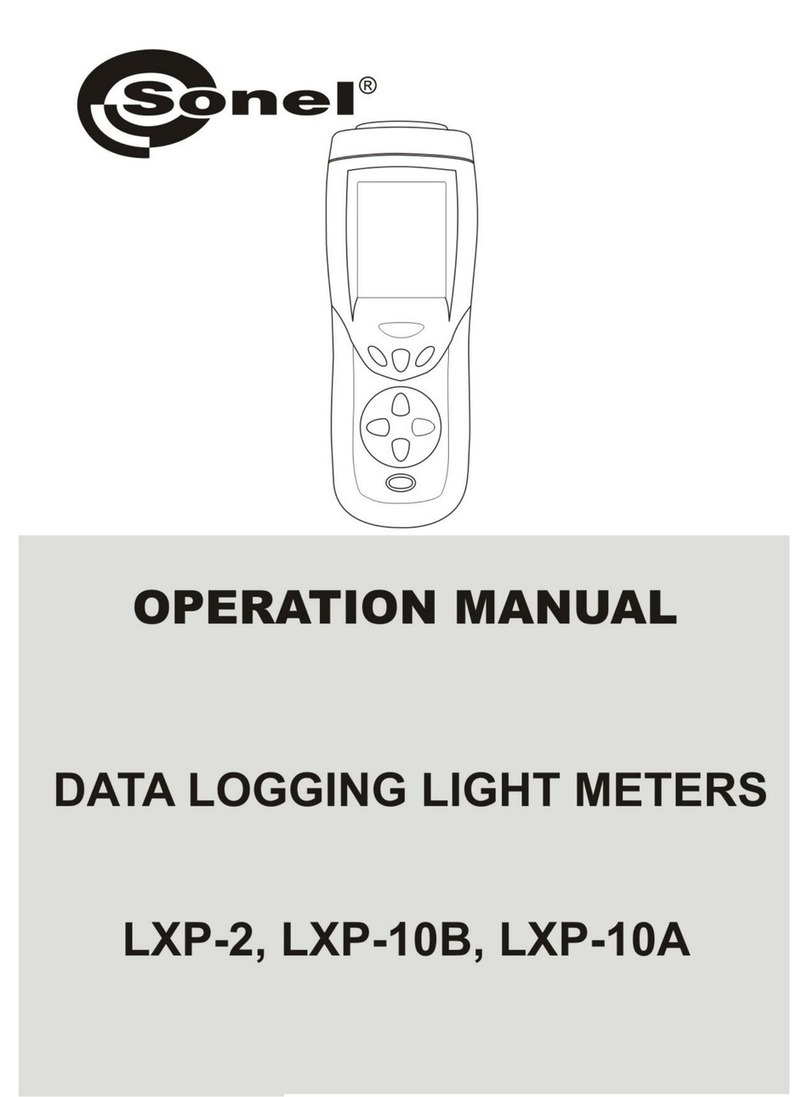
Sonel
Sonel LXP-2 User manual

Sonel
Sonel MZC-304 User manual
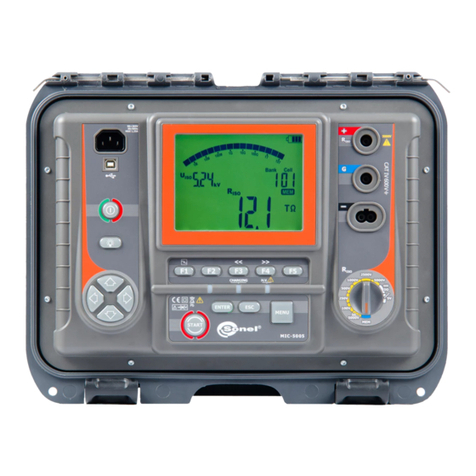
Sonel
Sonel MIC-5010 User manual
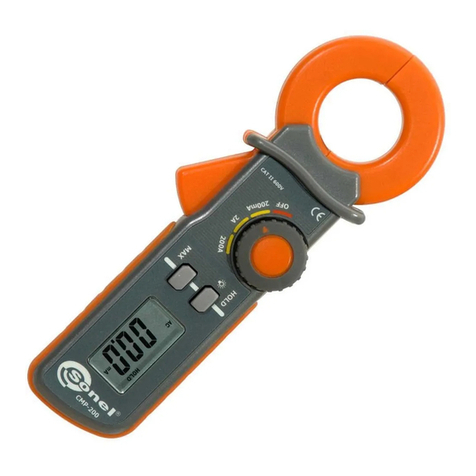
Sonel
Sonel CMP-200 User manual
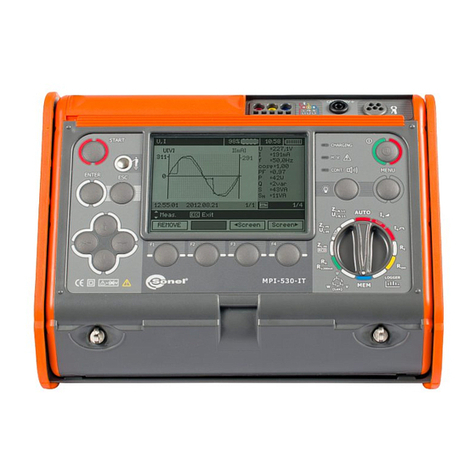
Sonel
Sonel MPI-530-IT User manual
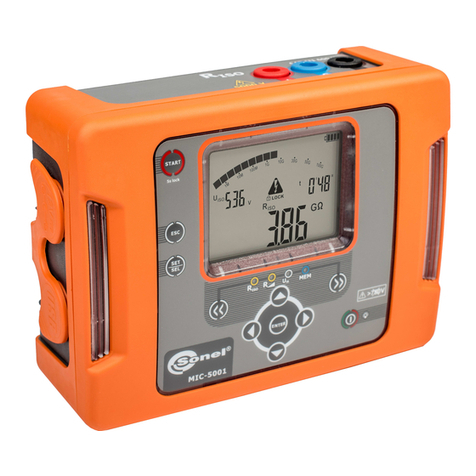
Sonel
Sonel MIC-5001 User manual

Sonel
Sonel MIC-10 User manual
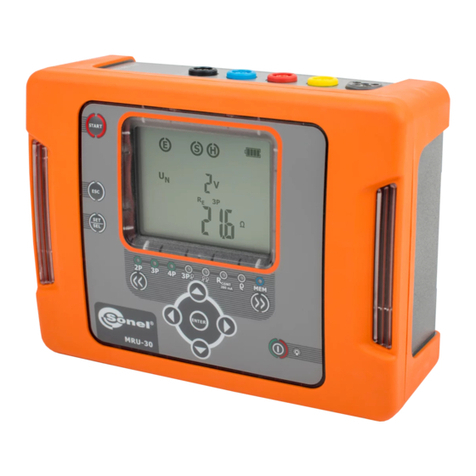
Sonel
Sonel MRU-30 User manual
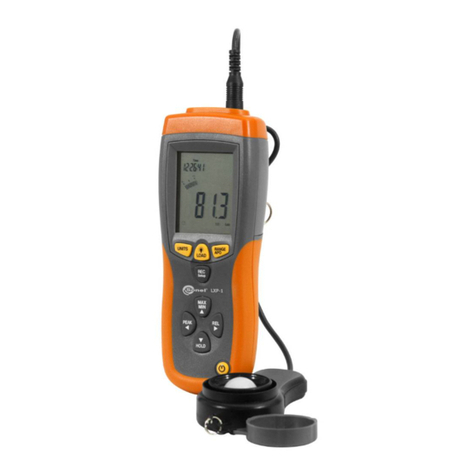
Sonel
Sonel LXP-1 User manual

Sonel
Sonel CMP-1015-PV User manual
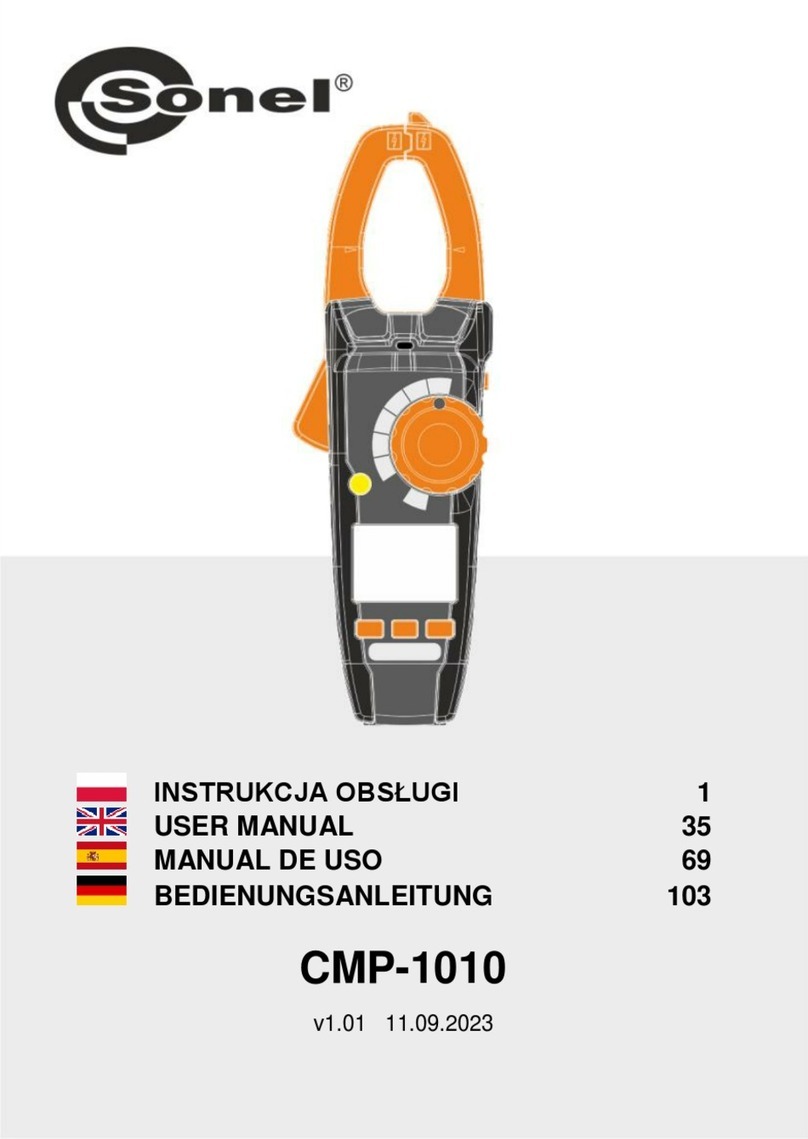
Sonel
Sonel CMP-1010 User manual
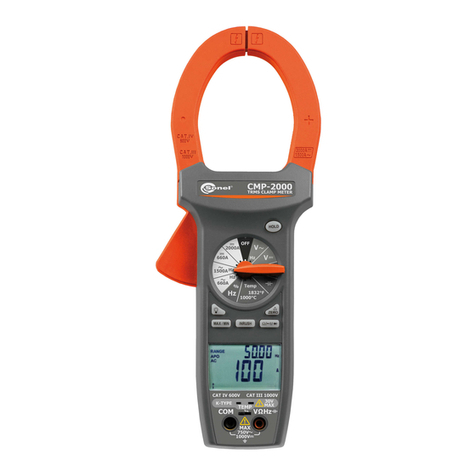
Sonel
Sonel CMP-2000 User manual

Sonel
Sonel MZC-305 User manual
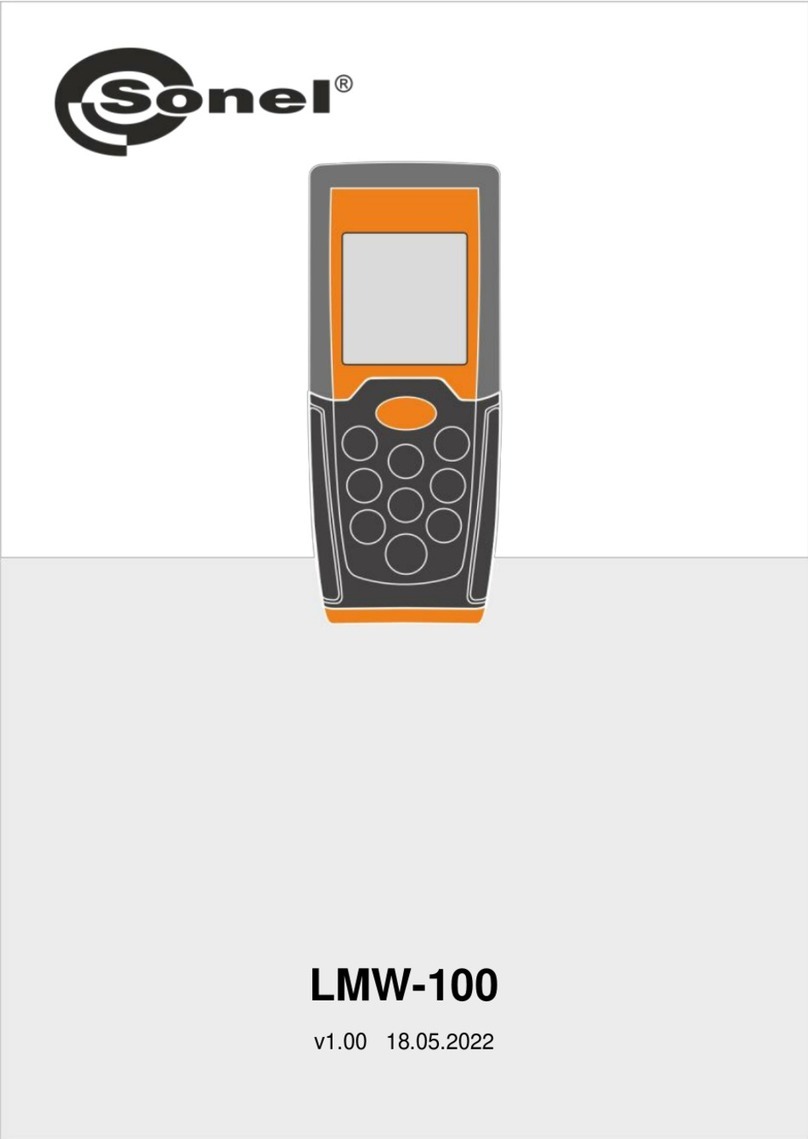
Sonel
Sonel LMW-100 User manual

Sonel
Sonel MMR-620 User manual

Sonel
Sonel CMP-400 User manual

Sonel
Sonel LKZ-2500 User manual
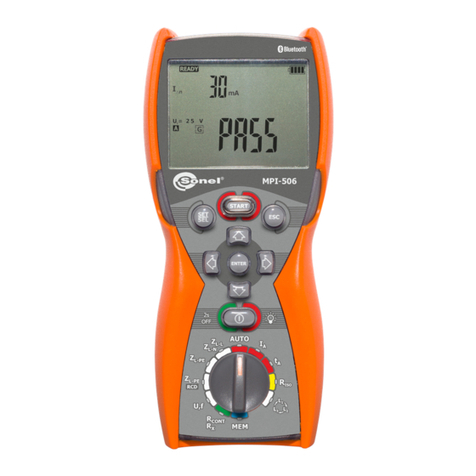
Sonel
Sonel MPI-506 User manual

Sonel
Sonel MRU-30 User manual


